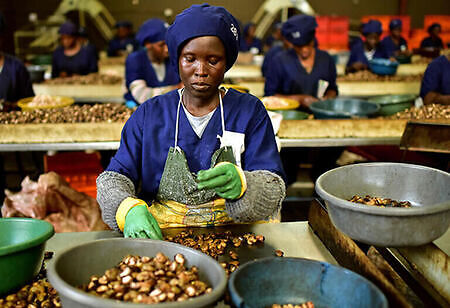
The Cashew Story: Scattering Light on Rural Life


When I start cherishing my childhood memories, the first thing that flashes in my mind is my grandparents' home—the plans we made for the few months of the summer holidays. The days used to seem cloudy, and it used to drizzle in the evenings. The foggy evenings hold the most memories. As all the cousins met up at one place, grandmother would tell the stories of her age while we sat around the firedamp. Pan on the fire will be filled with cashew nuts. The beam of happiness blistered when grandmother separated the kernel and cashew nut. There was no application of technology to separate the shell and the nut. Indeed, even then, the unique, nostalgic way of cashew nut separation is not just the source of our childhood happiness, but it paints happiness on a much broader canvas in the villages, as it is a serious source of income for many rural families.
In the Indian food processing sector, the cashew nut processing industry plays an authentic role. From cultivators, traders, wholesalers, and processors to supermarkets and retailers, the cashew processing sector is a vital source of income for millions, especially in south Karnataka, where you will find cashew factories in abundance.
It's a great omen now that local daily wage workers are moving to independent businesses. They buy the raw materials from markets or large factories. They keep three to four peeling machines at their home that will help them save time and grow their businesses. Many daily wage workers have become small-scale businessmen by depending on this business.
Problems Faced by Small Scale Businesses
Usually, SMEs face significant challenges in terms of access to finance, markets, good infrastructure, availability of trained manpower, and access to technology. The members of the KASSIA (Karnataka Small Scale Industries Association), and SMEs in general, always face the same problems. They are raising these issues on every available platform to impress upon the government the need to address them. When such a problem occurs, the government should address these issues by providing incentives for up-skilling, relaxation in GST collection, and quarterly below certain slabs. In addition, improvement in GST grievances redress mechanism, credit flow, reduction of real interest rates, and addressing key issues of the infrastructure deficit, both in the infrastructure and transportation, would help significantly.
For example, Cashew manufacturers in Mangalore have the problem of non-acceptance of invoice prices as per the Bill of Entry by the customs authorities in Mangalore. The manufacturers import sizeable quantities of cashew kernels in Mangalore as the local production is inadequate to meet the demand. But the customs authorities, who often reassess to increase the value of these imports by 60 to 80 percent, have become a big problem.
COVID Disrupted the Cashew Nut Harvesting
Karnataka is the second largest producer of raw cashew nuts after Kerala accounting for about 15 percent of the national output pegged at 5.5 lakh tonnes this year. Due to the pandemic, cashew nut harvesting came to a standstill. Besides, as the small-scale and large-scale processing were closed, the price crashed for raw nuts. At present, the raw nut prices ex-farmgate have crashed up to 45 percent to touch Rs. 70 per kg from Rs. 125 per kg during the last year's season.
But cashew farmers in Karnataka are in financial crisis due to the falling exports. They even preserve and sell the cashew’s pink layer to pharma companies as it is used in making medicines. In the last two years, many cashew businesses incurred huge losses due to a hefty increase in the raw material price, as there was no proportionate increase in the cost of the finished goods. The Coastal area of Karnataka produces 70 percent of the cashew crop. Besides, Dakshina Kannada has the most agricultural land for cashew cultivation, while the south of the state has large-scale cashew processing plants. So the rural units on the west coast produce about 100,000 metric tons of cashew kernels. In the form of some relief, the Indian Council for Agriculture Research (ICAR) has reportedly approved around 20 new varieties of cashews developed by scientists to be cultivated locally. Moreover, the New Mangalore Port Trust (NMPT) promotes cashew farming by providing regular container services to push the state to remain competitive in the import and export sector.
The cashew nuts are harvested during February–May. As a seasonal crop, it needs advanced planning for the next 30 years. This comes at a time when farmers are dropping cashew for other alternatives amid limited government support. The country used to export the crop to 60 countries in the world and now exports to around 45 countries, with a total of 3940 cashew processing facilities.
According to reports, the country's total cashew exports amounted to about 1, 40,000 tons seven years ago. Our country is in the race behind Vietnam and West Africa's Cote d’Ivoire. The main reason behind this is the cost of doing business in India, which has increased in the last five years in all sectors. On the other hand, the other Asian and African countries are rapidly advancing in mechanization and using technology in farming, hence getting more investment.
The local consumption in India is also growing, hence the demand. If consumption goes up regionally, they are unable to export as much. While India exports shelled cashew, it imports raw cashew to process and sells here regionally. However, as demand grew within the country, exports of shelled cashew fell in the last few years. India accounts for more than half of global cashew imports, while exports account for less than ten percent.